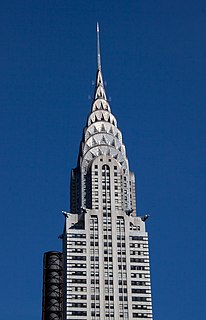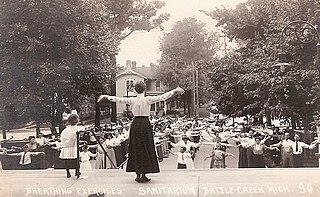
The Battle Creek Sanitarium was a health resort in Battle Creek, Michigan, United States, founded 1866 and originally based on the health principles advocated by the Seventh-day Adventist Church. Following the disfellowshipping of Dr. John Harvey Kellogg in 1907, Kellogg said that he and his employees were "independents" who "did not belong to any church" and the Sanitarium promoted Kellogg's theory of "biologic living" based on Adventist principles.

The Stuber–Stone Building is located at 4221–4229 Cass Avenue in Detroit, Michigan. It was listed on the National Register of Historic Places in 1996. It is now known as the Stuberstone Lofts.

The Fitchburg Historical Society is a historical society whose mission is to collect, preserve, and present the history of Fitchburg, Massachusetts. The society was founded in 1892, and is now headquartered in the historic Phoenix Building at 781 Main Street. The society's original 1912 headquarters building, designed by architect H. M. Francis, was listed on the National Register of Historic Places in 2003. The society operates 3 days a week and is open from 10am to 4pm Mondays and Tuesdays with a longer day on Wednesday from 10am to 6pm. They offer genealogical research, a library of local history, and numerous volunteer opportunities.
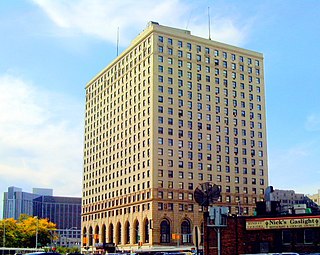
The Detroit-Leland Hotel is a historic hotel located at 400 Bagley Street in Downtown Detroit, Michigan. It is the oldest continuously operating hotel in downtown Detroit, and was listed on the National Register of Historic Places in 2005. The ballroom of the Detroit-Leland has hosted a nightclub, the City Club, since 1983. The hotel is now named The Leland and no longer rents to overnight guests.

The Whittier is a partially renovated high rise residential complex and former hotel located at 415 Burns Drive in Detroit, Michigan, on the Detroit River. It was listed on the National Register of Historic Places in 1985.

The Corbin Building is a historic office building located at 13 John Street at the corner of Broadway – where it is numbered as 192 – in the Financial District of Manhattan, New York City. It was built in 1888-89 and was designed by Francis H. Kimball in the Romanesque Revival style with French Gothic detailing. The building was named for Austin Corbin, a president of the Long Island Rail Road who also founded several banks. It was built as a speculative venture for use as office space or housing.
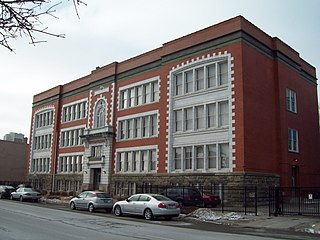
School 13, also known as Boys Vocational High School and Buffalo Alternative High School, is a historic school building located at Buffalo in Erie County, New York. It was built about 1915, and is a three-story, steel framed building sheathed in brick and terra cotta with Beaux-Arts style design elements. The "T"-shaped building housed administrative offices, classrooms, a gymnasium, swimming pool, and two-story auditorium. The building housed a school until 2003.
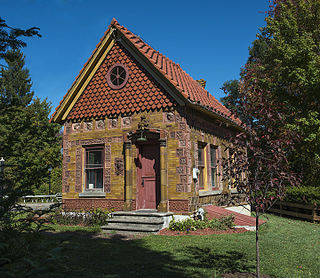
Terra Cotta Building is a historic office building and display center located at Alfred in Allegany County, New York. It was built in 1892 by the Celadon Terra Cotta Co and later sold in 1906, to the Ludowici Company of Ohio, which became the Ludowici-Celadon Company. It is a one-story, 16-foot-wide (4.9 m), 25-foot-deep (7.6 m) building built almost entirely of terra cotta bricks, ornamental and roofing tiles manufactured by Celadon. The building was designed as a sales office for the company, and was considered a "catalog" of their work. A replica was erected at the 1893 Columbian Exposition in Chicago. The building was the only remaining structure after a fire broke out on August 29, 1909 and destroyed what was at the time called Ludowici-Celadon Company.

Haskell School is a historic school building located at Troy in Rensselaer County, New York. It was built in 1894 and is a "T"-shaped, three story, red brick building on an elevated limestone basement in the Renaissance Revival style. It has a flat roof with a massive metal cornice. It features a majestic front entrance with a gated arch rising two stories over a tiled vestibule. The arch includes the inscription "Haskell School" in a terra cotta frieze. It was used as a school until 1975, then converted to apartments after 1977.

Public School No. 10 is a historic school building located at Troy in Rensselaer County, New York. It was built in 1898 and is an "H" shaped, three story, hard glazed orange brick building on an elevated basement in the Georgian Revival style. It has limestone and terra cotta trim. The entrance features a projecting terra cotta portico on a raised brick and limestone base. It was converted to multi-family housing in 1992.

The Bar Building is a historic commercial building designed by architect Benjamin Levitan and located at White Plains, Westchester County, New York.

Jamaica Chamber of Commerce Building is a historic office building located in the Jamaica section of the New York City borough of Queens. It was designed in 1928 by George W. Conable (1866-1933) and is a ten-story, "T" shaped building in the Colonial Revival style.

Andrew Carnegie Library is a library building located in Edmonds, Washington listed on the National Register of Historic Places. The building was constructed in 1910 after the city received a $5,000 grant from philanthropist Andrew Carnegie for the construction of a public library. The building numbers among its Beaux-Arts architectural features the Tiffany glass fan light over the main entrance and its terra cotta window and door surrounds and exterior corners.

Benjamin Franklin Academics Plus School is a historic elementary school located in the Crescentville neighborhood of Philadelphia, Pennsylvania. It is part of the School District of Philadelphia. The building was designed by Henry deCourcy Richards and built in 1915–1916. It is a two-story, five-bay, brick building on a raised basement in the Late Gothic Revival style. Additions were built in 1931 and 1954. It features entrances with carved stone and terra cotta surrounds and a brick parapet. The school was named for Benjamin Franklin.

The Civic Center Financial District is a historic district composed of five buildings near the intersection of Colorado Boulevard and Marengo Avenue in Pasadena, California. The Security Pacific Building and the Citizens Bank Building are located at the intersection itself and considered the centerpieces of the district, while the MacArthur, Mutual, and Crown Buildings are located on North Marengo. The buildings, which were built between 1905 and 1928, are all architecturally significant buildings used by financial institutions in the early 20th century.

The Spivey Building is a twelve-story skyscraper located at 417 Missouri Avenue in East St. Louis, Illinois. Built in 1927, the building is the only skyscraper ever constructed in East St. Louis. Architect Albert B. Frankel designed the building in the Commercial style. The building's design features terra cotta spandrels separating its windows vertically and brick pier dividing its window bays. The asymmetrical entrance is surrounded by decorative marble piers, and the first two stories are separated from the rest of the building by a cornice and sill. The top of the building features a two-story parapet with terra cotta surrounds at each window and seven capitals at its peak. During the height of East St. Louis' prosperity through the 1950s, the building housed the offices of professionals in many fields who were considered among the best in the city. However, the building became a victim of the city's steep economic decline and has been abandoned for several decades.

The Broadview Hotel is a historic hotel building located at 415 E. Broadway in East St. Louis, Illinois. The Classical Revival hotel was constructed in 1927. From its opening until the 1950s, the hotel was one of the finest in East St. Louis. It was added to the National Register of Historic Places in 2013.

The Grafton Bank is a historic bank building located at 225 E. Main St. in Grafton, Illinois. The Classical Revival building was constructed in 1913. The buff brick building features extensive terra cotta ornamentation on its front facade. A Diocletian window and terra cotta transom bar top the entrance, and terra cotta pilasters stand on either side. A classical entablature tops the entrance; the entablature includes an architrave, a frieze inscribed with the bank's name, and a dentillated three-section cornice. A brick parapet wall tops the facade; a stepped parapet recedes from the wall along the sides of the building. The bank which originally occupied the building closed in the 1930s, and the building has since been used for a variety of other, mainly commercial, purposes.
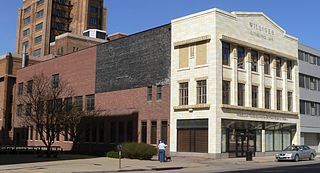
The Williges Building, also known as Cownie-Williges Building, is a historic building located in Sioux City, Iowa, United States. It is a three-story commercial block that was designed by local architects William L. Steele and George Hilgers. The structure was built for August Williges to house his fur manufacturing factory, salesroom, and storage facility. The decorative terra cotta details on the main facade are Sullivanesque in style, which reflects Steele's association with Louis Sullivan from 1897 to 1900. Completed in 1930, it is one of the last commercial buildings constructed in the early Prairie School style in the United States, and Steele's last architectural commission in Sioux City. It was also built at the end of the period of time when terra cotta was popularly used as wall cladding. The building was listed on the National Register of Historic Places in 2007.
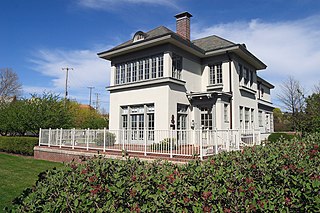
The W.K. Kellogg House, located at 1 Monroe Street in Battle Creek, Michigan, was built as a private house for Kellogg Company founder Will Keith Kellogg. It was listed on the National Register of Historic Places in 1985. In 1990, it was moved from its original location at 256 West Van Buren Street to its present location near the W.K. Kellogg Foundation headquarters.



